Abstract
In 2021 as part of a research on apterygotes in Iran 18 specimens of Protura were collected; 14 of them were identified as Acerella muscorum (Ionesco, 1930), one was an Acerentomon belonging to the affine group, three were female specimens of a new species of Acerentulus described in this paper. Like other species belonging to confinis group, Acerentulus iranicus sp. nov. has a complete row of posterior setae (18) on tergite VII, a long foretarsal sensillum a almost reaching seta γ3, and sensilla b and c almost of the same length, both passing the base of seta γ3. The closest species to A. iranicus sp. nov. is A. setosus Szeptycki, 1993 from Western Caucasus (Russia). This species differs from the new species for its smaller pseudoculi, the ratio between mesothoracic setae P1 and P2, the presence of a doubled pore on tergite XII, and the longer foretarsal sensillum a. The partial description of an undetermined specimen of Acerentomon belonging to the affine group is outlined too. A key to the Protura species known from the Middle East is provided.
http://www.zoobank.org/urn:lsid:zoobank.org:pub:A0243956-A081-4D5D-8FEA-361CA7123852
Introduction
To date more than 800 species of Protura, belonging to three orders, seven families and 77 genera are known worldwide (Szeptycki Citation2007; Galli et al. Citation2018; Galli & Rellini Citation2020). One of the less studied areas as regards this group of euedaphic microarthropods is the Middle East (see https://www.britannica.com/place/Middle-East), with the vast majority of data referring to Israel.
In the course of 2021 soil samples were collected in Iran as part of a research on apterygotes, some proturans were extracted and subsequently examined. The purpose of this paper is to integrate what is already known about this taxon from the Middle East with the new records, also describing a new species belonging to the genus Acerentulus, confinis group (Shrubovych et al. Citation2019) and outlining a partial description of an Acerentomon male specimen belonging to the affine group. A key for identification of the species of Protura of this region is also provided.
Material and methods
Soil samples of 1 kg each were collected in two localities of the Mazandaran province () and extracted by means of Berlese-Tullgren funnels for five days. Specimens were preserved in 70% ethanol.
Figure 1. Sampling area. (a) Northern part of Iran: the red dot indicates Behshahr city in Mazandaran province; (b) Pasand forest, near Behshahr; (c) Imamzadeh Yusuf, near Behshahr.
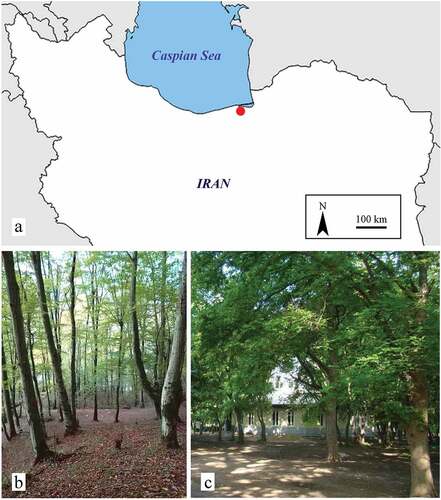
For the identification, proturans were incubated at 40‒50°C for 24 hours in lactic acid to make them clear, then mounted on slides in Marc André II medium. Specimens were then observed and identified to species and life-stage levels with the aid of an interference contrast microscope (Leica DM LB2), a Leica DFC 295 camera and Leica Application Suite Vers. 3.8.
This system was also used to examine and take diagnostic measurements of each Acerentulus iranicus sp. nov. and Acerentomon sp. 1 specimen (see Nosek Citation1973). For the description of morphological characters, the terminology used by Szeptycki (Citation1991), Rusek et al. (Citation2012), and Shrubovych (Citation2014) was adopted. In particular for the ratios between measurements, the following acronyms were used:
LR = labral ratio = length of the head (without rostrum)/length of the rostrum starting from the base of labial setae
PR = pseudoculus ratio = length of the head (without rostrum)/length of pseudoculus
CF = head length/hind part of maxillary gland length
TR = tarsus ratio = length of foretarsus/length of claw
EU = empodium/unguis ratio = length of empodium/length of foretarsal claw
BS = base/sommet ratio = distance of foretarsal sensillum t1 from the base of tarsus/distance of t1 from the apex of tarsus.
Results
Totally in the two sampling sessions 18 specimens of Protura were collected, belonging to three species. These new data are added to those relating to nine species already known from the Middle East area in literature (even though not strictly belonging to the Middle East area, we included also a record from a locality in Azerbaijan about ten kilometers far from the border with Iran). Some in depth data on each species are reported below.
List of Protura of the Middle East
ORDER ACERENTOMATA
FAMILY PROTENTOMIDAE
SUBFAMILY PROTENTOMINAE
Proturentomon pectinatum (Condé, 1948)
Lebanon: 1 female, Ouasa el Bechane (Caza Jounie, mohafazat Mont Liban), 450 m elev., olive tree plantation, 10.XI.1951, coll. H. Coiffait (Condé Citation1954).
Distribution. North Africa, Near East, South Europe (Szeptycki Citation2007).
FAMILY ACERENTOMIDAE
SUBFAMILY BERBERENTULINAE
Acerentulus iranicus, sp. nov.
Iran: 1 female, Imamzadeh Yusuf, near Behshahr (Mazandaran prov.), 36°43′19″N - 53°37ʹ7″E, 3 m elev., soil under an Oak tree, December 2020, coll. S. Moghadam; 2 females, Pasand forest, near Behshahr (Mazandaran prov.), 36°39ʹ56″N - 53°36ʹ46″E, 357 m elev., soil and leaf litter under Oak and Alder trees, October 2021, coll. S. Moghadam.
See the description below.
Berberentulus berberus (Condé, 1948)
Israel: 60 individuals, Mount Carmel, slopes of Nahal Galim, 400 m elev., pine forest, 1991‒1992, coll. Broza et al. (Broza et al. Citation1996).
Distribution. Central and West Europe, Near East (Szeptycki Citation2007).
Gracilentulus fjellbergi Szeptycki, 1993
Azerbaijan: 2 females, between the villages Lankoran and Astara, salt meadow on Caspian sea shore, 29.I.1982, coll. M. Potapov (Szeptycki Citation2004).
Distribution. Europe, Near East (Azerbaijan).
Tuxenidia hermonensis Szeptycki and Broza, Citation2004
Israel: 1 male, 1 adult, Mt. [Har] Hermon, 1600 m elev., under Juniperus drupacea, 6.VI.1993, coll. M. Broza (Szeptycki & Broza Citation2004)
Distribution. Type area only (Szeptycki Citation2007).
SUBFAMILY ACERENTOMINAE
Acerentomon brozai Szeptycki and Shrubovych, Citation2008
Israel: 1 male, 1 larva II, Upper Galilee, Amirim, unburnt planted pine forest, 28.I.1995, coll. M. Broza and D. Poliakov; 1 praeimago, 1 maturus junior, Mount Carmel, Reches Etzba, burnt and unburnt pine forest (Pinus halepensis), 22.XI.1994 and 16.IV.1995, coll. M. Broza and D. Poliakov; 1 female, 1 praeimago, 3 maturi juniores, 2 larvae II, 1 larva I, Mount Carmel, Givat Wolfson, burnt pine forest (Pinus halepensis), 15.XII.1995, coll. M. Broza and D. Poliakov; 1 maturus junior, 1 larva II, Sha’ar Hagai, on the way to Jerusalem, unburnt area, 15.IV.1996; 1 male, 2 females, Mount Carmel, Nahal Oren, northern slope, pistachio-oak forest (Pistacia palestina, Quercus calliprinos), 9.III.1997, coll. M. Broza and D. Poliakov; 1 female, Mt. Hermon, 1600 m elev., under Juniperus drupacea, 1.VI.1997, coll. M. Broza and D. Poliakov; 1 male, 2 maturi juniores, Judean Hills, Adulam, low trees (mainly Quercus calliprinos and Pistacia palestina) with dense shrubs of Phyllirea latifolia and Pistacia lentiscus on limestone, 4.IV.2004, coll. M. Broza and D. Poliakov (Szeptycki & Shrubovych Citation2008).
Distribution. Type area only.
Acerentomon dominiaki Szeptycki, Citation1977
Turkey: 1 male, 1 female, Ayvacik, 12.X.2014, coll. S. Sullivan (L. Galli unpub.).
Iran: 1 male, 5 females, some praeimagines and maturi juniores, 20 km south of Shahshavar, 2400 m elev., beech forest, 22.VIII.1972, coll. B. Dominiak (Szeptycki Citation1977).
Distribution. Middle East.
Acerentomon sp. 1
Iran: 1 male, Pasand forest, near Behshahr (Mazandaran prov.), 36°39ʹ56″ N–53°36ʹ46″E, 357 m elev., soil and leaf litter under Oak and Alder trees, October 2021, coll. S. Moghadam.
See the (partial) description below.
SUBFAMILY ACERELLINAE
Acerella muscorum (Ionesco, 1930)
Israel: 289 individuals, Mount Carmel, slopes of Nahal Galim, 400 m elev., pine forest, 1991‒1992, coll. Broza et al. (Broza et al. Citation1996).
Iran: 3 females, Imamzadeh Yusuf, near Behshahr (Mazandaran prov.), 36°43ʹ19″ N–53°37ʹ7″E, 3 m elev., soil under an Oak tree, December 2020, coll. S. Moghadam; 1 male, 10 females, Pasand forest, near Behshahr (Mazandaran prov.), 36°39ʹ56″ N–53°36ʹ46″E, 357 m elev., soil and leaf litter under Oak and Alder trees, October 2021, coll. S. Moghadam.
Distribution. Central and West Europe, Near East (Szeptycki Citation2007).
ORDER EOSENTOMATA
FAMILY EOSENTOMIDAE
SUBFAMILY EOSENTOMINAE
Eosentomon boguslavi Szeptycki, Citation1977
Iran: 1 male, 20 km south of Shahshavar, 2400 m elev., beech forest, 22.VIII.1972, coll. B. Dominiak (Szeptycki Citation1977).
Distribution. Type area only (Szeptycki Citation2007).
Eosentomon iranicum Szeptycki, Citation1977
Iran: 2 females, 20 km south of Shahshavar, 2400 m elev., beech forest, 22.VIII.1972, coll. B. Dominiak (Szeptycki Citation1977).
Distribution. Type area only (Szeptycki Citation2007).
Taxonomic account
Acerentulus iranicus sp. nov.
; .
Figure 2. Acerentulus iranicus sp. nov. (interference contrast microscope). (a) Maxillary gland (side view); (b) Thorax (dorso-lateral view): arrows indicate sl pores; (c) Mesosternum; (d) Metasternum; (e) Abdominal sternites I–III: arrows indicate abdominal appendages. Scale bars 50 μm. Figures (a, e): holotype. Figures (b–d): paratype.
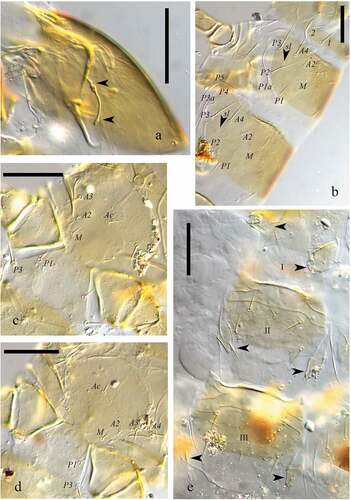
Figure 3. Acerentulus iranicus sp. nov. Paratypes (interference contrast microscope). (a) Tergites VI–VII: arrows indicate pores; (b) Tergites VIII–XII: arrow indicates pore; (c) Sternites VI–VII: arrows indicate pores and the granular area between tergite and pleurite VI (Ple); (d) Sternites VIII–XII: arrow indicates pore; (e) Detail of Tergite VIII: arrows indicate psm pore and comb VIII; (f) Detail of female squama genitalis: arrows indicate the acrostyles. Scale bars 50 μm (a–d) - 20 μm (e, f).
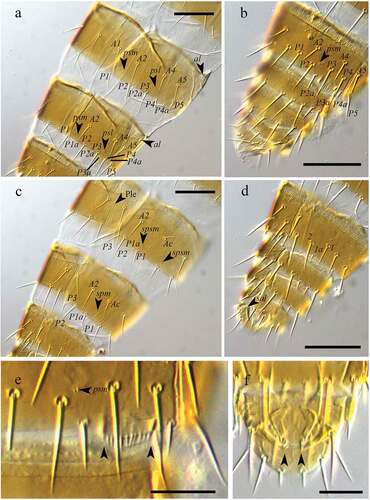
Figure 4. Acerentulus iranicus sp. nov. (a) Head, lateral view; (b) Maxillary palpus; (c) Labial palpus; (d) Pseudoculus; (e) Canal of maxillary gland; (f) Foretarsus, exterior view; (g) Foretarsus, interior view; (h) Pro, meso and metanotum; (i) Prosternum; (l) Mesosternum; (m) Metasternum. Arrows indicate pores. Figures (a‒h): holotype; Figures (i‒m): paratypes. Scale bars: 50 μm (a, f‒m) - 20 μm (b‒e).
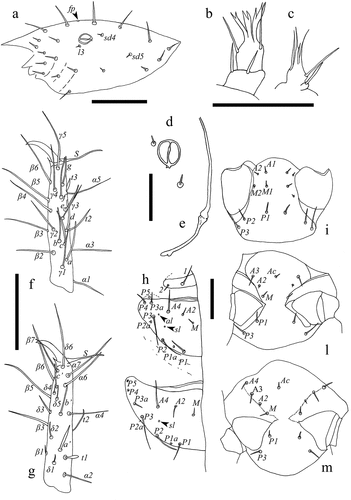
Figure 5. Acerentulus iranicus sp. nov. (a) Tergites V–VII; (b) Sternites V–VII; (c) Tergites VIII–XII; (d) Sternites VIII–XII. (e) Abdominal appendage II; (f) anterior margin of pleurite VII; (g) Comb on abdominal tergite VIII; (h) female squama genitalis. Arrows indicate pores. Figures (a, e, f): holotype; Figures (b, c, d, g, h): paratypes. Scale bars: 50 μm (a‒d) - 20 μm (e‒h).
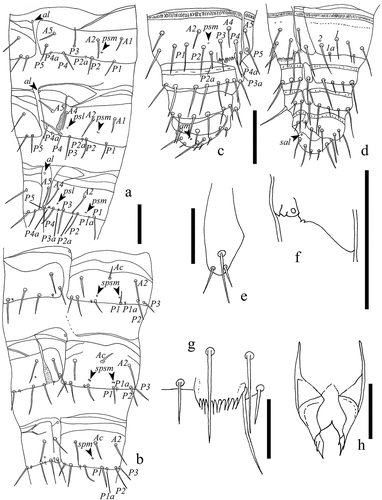
Table I. Acerentulus iranicus sp. nov. chaetotaxy
Table II. Acerentulus iranicus sp. nov. porotaxy
Type material. Holotype:
female from Pasand forest, near Behshahr (Mazandaran prov.), 36°39ʹ56″ N–53°36ʹ46″E, 357 m elev., soil and leaf litter under Oak and Alder trees, October 2021, coll. S. Moghadam.
Paratypes
Two females, one from the same collection of the holotype and one from Imamzadeh Yusuf, near Behshahr (Mazandaran prov.), 36°43ʹ19″N–53°37ʹ7″E, 3 m elev., soil under an Oak tree, December 2020, coll. S. Moghadam.
Description. When not indicated, measurements and ratios refer to the holotype.
Body length: 1333‒1364 μm (n = 2).
Head 130 μm long in dorsal view. Setae sd4, sd5 and l3 short and thin; seta d6 absent (). Frontal pore fp present slightly ahead of the level of the pseudoculi ()). Pseudoculus almost circular, diameter 10‒11 μm (n = 2), longitudinally divided ()); PR = 13. Maxillary gland with rounded calyx, long and slender posterior filament and bilobed posterior dilation (); proximal part 26‒34 μm long (n = 2), CF = 5. Maxillary palps with two slender pointed sensilla ()). Labial palps with apical tuft of setae and a rather large pointed sensillum ()).
Foretarsus length 88 μm (n = 2), claw 26 μm, without inner tooth or outer flap, TR = 3.4; empodium length 4 μm, EU = 0.15; S-shaped seta nearly as long as claw, 27 μm. Sensillum t1 claviform: BS = 0.34‒0.35 (n = 2); t2 slender; t3 shaped like a willow leaf. Sensillum a passing the base of d; b and c almost of the same length; d slightly closer to c than to e, passing e; e long, reaching the base of g; f halfway between e and g, passing the base of claw. Sensillum a’ sword-shaped and distal to t1, short, not reaching the base of b’; b’ reaching the base of c’; c’ thin, its apex barely reaching the base of claw. Ventral seta β1 thin, 6 μm long, as long as the interior seta δ4; δ4 situated proximally to c’ (). Middle tarsus length 37 μm; claw length 18 μm. Hind tarsus length 41‒42 μm (n = 2); claw length 19 μm (n = 2).
Chaetotaxy given in (see also ). Length ratio of setae 1:2 on pronotum as 2‒2.3:1 (n = 3); ratio P1:P2 on mesonotum as 1:1.4‒1.7 (n = 3). Tergites I–V each with three pairs of anterior setae (A1, A2, A5). Setae P1a and P3a absent on tergites I–VI. Seta P3 anterior to the row of the other P-setae on tergites II–V. Complete row of P-setae on tergite VIII, on which A1 is missing. Posterior margin of pleurite VIII smooth. No chaetal variability was recorded in the three specimens examined.
Porotaxy given in . Pores psm on tergites I‒VII flanked by two tiny teeth. On meso- and metanotum sl pores present ()); al pore present only on mesonotum ()). Psm pores present on abdominal tergites I‒VIII; al on tergites II‒VII; psl on VI and VII (). Thoracic sternites and abdominal sternites I‒III without pores (). Sternites IV and V with spsm pores near the base of P1 ()). Sternite VI with composed spsm pores (2) symmetrically placed anterior to P1. Sternite VII with a spm pore near its hind margin, between P1 setae (). Anterior margin of pleurite VII with two small pointed teeth ().
Connecting lines on anterolateral corners of sternites IV‒VI absent or just barely visible. Abdominal appendages II and III typical of genus Acerentulus (). Granular latero-dorsal area on tergite VI with a “sub-triangular” shape (). Striate band on abdominal segment VIII is well developed, with distinct striae (); comb with about 9–11 rather regular teeth (). Almost continuous row of minute granules posterior to the striate band on the sternite; just few scattered granulations on the tergite (). Male squama genitalis unknown. Female squama genitalis with distinct distal prolongation on stylus and long pointed acrostylus ().
Ethymology. The name iranicus refers to the country where type specimens have been collected.
Diagnosis and discussion. Acerentulus iranicus sp. nov. belongs to confinis species group (Nosek Citation1973; Shrubovych et al. Citation2019) according to the long foretarsal sensillum a almost reaching seta γ3, and to sensilla b and c of similar length (b is just slightly longer than c). A key to the species belonging to such group is available in Shrubovych et al. (Citation2019). Moreover, the new species is characterized by the absence of seta P1a on tergites I‒VI and by the presence of three pairs of A-setae and a complete row of P-setae on tergite VII. Among those species sharing these characters, A. xerophilus Szeptycki, 1979 differs for the chaetotaxy of tergites I‒VI, for the presence of pores on meso- and metasternum and for a much longer tarsus (98‒102 μm; TR = 3.9‒4.4). Acerentulus palissai Nosek, 1967 shows a different dorsal chaetotaxy of segments II‒VI and its sensillum c is significantly longer than b. Acerentulus confinis maderensis Tuxen, 1982 shares with the new species the same chaetotaxy, but it has shorter sensilla b and c barely reaching seta γ3, sensillum c’ is nearly at the same level of seta δ4, its body size is smaller (length = 850 μm) and its tarsus is longer (98 μm). The closest species to A. iranicus sp. nov. results to be A. setosus Szeptycki, 1993. This last species differs from the one described here for its smaller pseudoculi (6‒7 μm, PR = 15‒19), the ratio between mesothoracic setae P1 and P2 (almost of the same length), the presence of a doubled pore on tergite XII, and the longer foretarsal sensillum a (passing seta γ3). The type locality of A. setosus (Krasnodar Krai, Russia, 50 km far from the Black Sea) seems to support the close affinity with A. iranicus sp. nov. also from a geographical point of view.
Acerentomon sp. 1
; .
Figure 6. Acerentomon sp. 1. male (interference contrast microscope). (a) Head (dorsal view): arrow indicates the frontal pore (fp); (b) Foretarsus (exterior side): arrows indicate the ends of sensillum b; (c) Tergites VIII‒XII: arrows indicate granulations behind the striate band (gr), pores (psm and am) and comb VIII (comb); (d) Sternites VIII‒XII: arrows indicate granulations behind the striate band (gr), the anomalous posterior seta on sternite VIII (an) and the toothed posterior margin of pleurite VIII (pl); (e) Detail of the maxillary gland; (f) Detail of pleural pectine VI. Scale bars: 50 μm (a, c, d) - 20 μm (b, e, f).
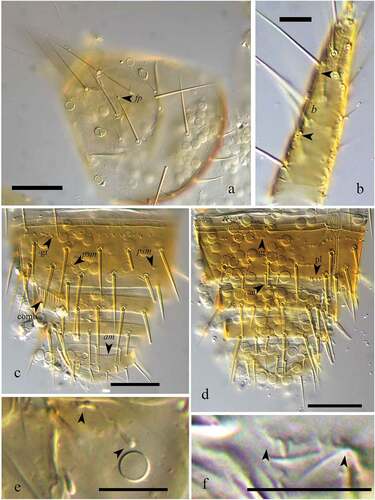
Figure 7. Acerentomon sp. 1. male. (a) Detail of rostrum and labial setae; (b) Labial palp; (c) Male squama genitalis. Scale bars: 50 μm (a, c) - 20 μm (b).
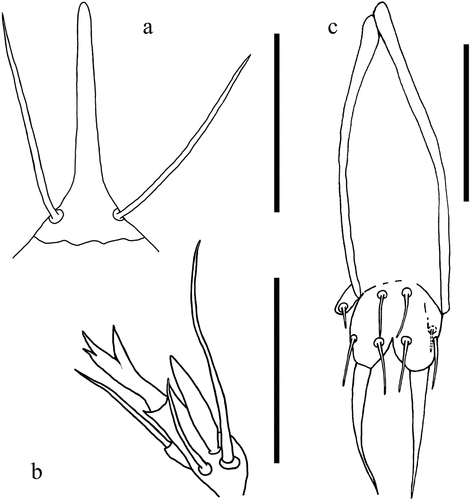
Table III. Acerentomon sp. 1 chaetotaxy
Table IV. Acerentomon sp. 1 porotaxy
Material examined. Male from Pasand forest, near Behshahr (Mazandaran prov.), 36°39ʹ56″N–53°36ʹ46″E, 357 m elev., soil and leaf litter under Oak and Alder trees, October 2021, coll. S. Moghadam.
Description. Measurements (μm) – Body length 1975, head length without rostrum 180, rostrum length 60, proximal part of the maxillary gland length 23, pseudoculus 11 (length) × 10 (width), foretarsus length 128, middle tarsus and relative claw length 72 and 30, hind tarsus and relative claw 77 and 33. Length of pronotal setae: 1 74, 2 30. Length of mesonotal setae: P1 74, P1a 69, P2 71. Ratios: LR = 3, PR = 11.6, CF = 5.6, TR = 2.8, BS = 0.56, length ratio of setae 1:2 on pronotum as 2.5:1, ratio P1:P1a:P2 on mesonotum as 1.1:1:1. The head length could be not exact since the head capsule seems to be a bit deformed due to the preparation, therefore in the diagnosis we did not consider LR, CF and PR ratios which were considered not fully reliable.
Head without additional setae d6; frontal pore placed in line with the anterior margin of pseudoculi; rostrum very long, a bit longer than labial setae; pseudoculi subcircular, slightly longer than broad; maxillary gland typical of genus Acerentomon, with a short proximal part; labial palps with a large leaf-shaped basal sensillum (). Foretarsal sensillum a large, reaching halfway the bases of c and d; sensillum b long, sword-shaped, reaching the base of t3 (); d rather short, slightly passing t3. Tarsal pore present near the base of sensillum c. Pleural pectine VI with five to six distinct teeth; comb VIII with 14 irregular teeth; hind margin of pleurite VIII with five teeth; hind margin of abdomen XII with six to seven teeth (). Striate band well developed followed by a row of minute granules which is straight and continuous on tergite, curved on pleurites and discontinuous on sternite (). Chaetotaxy and porotaxy are shown in , respectively. Male squama genitalis is illustrated in . Female squama genitalis unkown.
Remarks. The Acerentomon specimen examined belongs to the “affine group” sensu Nosek (Citation1973) being characterized by the presence of 4/2 setae on sternite VIII, and tergite VII without seta x. Unfortunately we were unable to fully describe a new Acerentomon species based on the only male specimen collected. Anyway it can be distinguished from all the other species belonging to the “affine group” by some characters which are summarized below (see Tuxen Citation1964; Nosek Citation1973).
Acerentomon affine Bagnall, 1912 has a rostrum of medium length, shorter than labial setae. Foretarsal sensillum b is long, but only reaching halfway between seta γ3 and sensillum t3. Chaetotaxy differs from that of the new specie for the presence of 4 setae on tergite XI and 5/5 on sternite II. The posterior margin of pleurite VIII has 5‒7 very small teeth. Ratio BS is 0.75 and TR 2.5.
Acerentomon bagnalli Womersley, 1927 has a much shorter sensillum b only reaching the base of seta γ3. Chaetotaxy is the same of A. affine. Ratio BS is 0.7.
In A. hylophilum Rusek, 1966 rostrum is of medium length, shorter than labial setae. Foretarsal sensillum a is long, reaching the base of e; b only reaches the base of seta γ3. Sternite II has 3(4)/5 setae. On sternite VIII two series of granulations are present posteriorly to the striate band. Ratio TR is 2.2‒2.4
Acerentomon novaki Rusek, 1965 has a very short rostrum. On tergite I are present 6/12 setae; on sternites II and VII 5/5 and 5/8 setae, respectively. Ratios: BS = 0.8, TR = 2.5.
Acerentomon oblongum Womersley, 1927 is very similar to A. affine for many features (TR, foretarsal sensilla size and arrangement, and chaetotaxy). BS is 0.8.
Based on these data, it is rather difficult to choose among those mentioned a more similar species, but it is unquestionable that the specimen described belongs to a new taxon.
Discussion
After this work, the Protura fauna of the Middle East results made up of eleven species, nine of which belonging to order Acerentomata (one Protentomidae and eight Acerentomidae), and two of the order Eosentomata, family Eosentomidae. This richness value must be considered widely underestimated, due to the very low sampling effort in the whole area (null in some countries). In comparison, referring to neighboring countries respectively to the north and south of the Mediterranean, 14 species are known from Greece (Szeptycki Citation2007; Galli et al. Citation2017) and 7 from Algeria (Szeptycki Citation2007).
The dominant species in the studied locality in Iran is Acerella muscorum for which it has been recorded a sex ratio (1 male vs 13 females) that confirms the population unbalance toward females already known for this species in Italy and for other species all over the world as well (Galli et al. Citation2019a, Citation2019b, Citation2021). The remaining four specimens belong to a new Acerentulus species and to an undetermined Acerentomon species.
Key to the Protura species from the Middle East
Spiracles present on meso- and metanotum; three pairs of two-segmented abdominal appendages 2
– Spiracles absent; abdominal appendages III always uni-segmented 3
Labral setae present; foretarsal sensillum a almost reaching the base of seta γ2; foretarsus shorter than 110 μm Eosentomon iranicum Szeptycki, Citation1977
– Labral setae absent; foretarsal sensillum a not reaching the base of seta γ2; foretarsus ≥120 μm Eosentomon boguslavi Szeptycki, Citation1977
Abdominal appendages I–II two-segmented, III uni-segmented; metanotum with only one pair of A-setae (A2); pseudoculi with a large triangular proximal prolongation Proturentomon pectinatum (Condé, 1948)
– Abdominal appendages I two-segmented, II–III uni-segmented; metanotum with at least two pairs of anterior setae (A2, A4); pseudoculi without prolongation 4
Abdominal appendages II–III each with three setae; the subapical long, the lateral apical shorter and the median apical the shortest Acerentulus iranicus sp. nov.
– Abdominal appendages II–III each with two setae (subapical and lateral apical or median apical) 5
Seta P3 on tergites II–VI in line with the other posterior setae 6
– Seta P3 on tergites II–VI anterior to the other posterior setae 9
Canal of maxillary glands with lateral verrucose appendices on calyx; foretarsal sensillum t1 long, filiform; lateral apical and subapical setae on abdominal appendages II–III subequal in length Acerella muscorum (Ionesco, 1930)
– Calyx of maxillary glands small and simple; foretarsal sensillum t1 claviform; the median apical seta on abdominal appendages II–III is less than half the length of the subapical one 7
Sternite VIII with 4/2 setae; foretarsal sensillum b large, sward-shaped Acerentomon sp. 1
– Sternite VIII with only 4 setae 8
Coxal incisions on meso and metasternum distinct; pleural pectines V and VI with few little distinct teeth; comb VIII with 12‒15 teeth; TR = 3.4‒3.9 Acerentomon brozai Szeptycki & Shrubovych, Citation2008
– Coxal incisions on meso and metasternum indistinct or absent; pleural pectines V and VI with some well distinct teeth (about 20 in pleurite VI); comb VIII with 8‒10 teeth; TR = 2.6‒2.7 Acerentomon dominiaki Szeptycki, Citation1977
Foretarsal sensillum t1 baculiform Tuxenidia hermonensis Szeptycki & Broza, Citation2004
– Foretarsal sensillum t1 claviform 10
Striate band well developed Gracilentulus fjellbergi; Szeptycki, 1993
– Striate band reduced, formed by two transverse lines, the more distal serrated, the proximal one more or less undulated with small teeth Berberentulus berberus (Condé, 1948)
Acknowledgements
The authors wish to thank Dr Antonio Sarà for his kind help in the preparation of slides. Thanks also to Dr Sebahat Ozman-Sullivan for the two prepared specimens he sent to the corresponding author from Turkey. Last but not least, we are grateful to the reviewers whose comments and suggestions have been very valuable to improve our manuscript.
Disclosure statement
No potential conflict of interest was reported by the author(s).
References
- Broza M, Poliakov D, Szeptycki A. 1996. First record of Protura (Hexapoda) in Israel with notes on their distribution and ecology. Israel Journal of Entomology 30:1‒5.
- Condé B. 1954. Mission Henri Coiffait au Liban (1951). 4. Protoures et Diploures Compodéidés. Archives de Zoologie expérimentale et générale 91:397‒412.
- Galli L, Capurro M. 2013. Acerentulus shrubovychae sp. nov. from Italy (Protura: Acerentomidae). Zootaxa 3609(4):431–436. DOI: 10.11646/zootaxa.3609.4.5.
- Galli L, Capurro M, Lionetti G, Zinni M. 2017. Acerentulus tortii sp. nov. from Greece (Protura: Acerentomidae). Zootaxa 4232(3):437–443. DOI: 10.11646/zootaxa.4232.3.12.
- Galli L, Shrubovych J, Bu Y, Zinni M. 2018. Genera of the Protura of the world: Diagnosis, distribution, and key. ZooKeys 772:1–45. DOI: 10.3897/zookeys.772.24410.
- Galli L, Capurro M, Colasanto E, Molyneux T, Murray A, Torti C, Zinni M. 2019a. A synopsis of the ecology of Protura (Arthropoda: Hexapoda). Revue suisse de Zoologie 126(2):155‒164. DOI: 10.5281/zenodo.3463443.
- Galli L, Capurro M, Molyneux T, Torti C, Zinni M. 2019b. Ecology of Italian Protura. Pedobiologia 73:20‒28. DOI: 10.1016/j.pedobi.2019.01.004.
- Galli L, Rellini I. 2020. The geographic distribution of Protura (Arthropoda: Hexapoda): A review. Biogeographia – The Journal of Integrative Biogeography 35:51–69. DOI: 10.21426/B635048595.
- Galli L, Janžekovič F, Kozel P, Novak T. 2021. Protura (Arthropoda: Hexapoda) in Slovenian caves. International Journal of Speleology 50(1):65‒74. DOI: 10.5038/1827-806X.50.1.2380.
- Nosek J. 1973. The European Protura, their taxonomy, ecology and distribution with keys for determination. Genève: Muséum d’Histoire Naturelle. pp. 345.
- Rusek J, Shrubovych J, Szeptycki A. 2012. Head porotaxy and chaetotaxy of order Acerentomata (Protura). Zootaxa 3262:54–61. DOI: 10.11646/zootaxa.3262.1.5.
- Shrubovych J. 2014. Identification and character analysis of the Acerentomidae (Protura) of the northeastern Palearctic (Protura: Acerentomidae). Zootaxa 3755(2):136–164. DOI: 10.11646/zootaxa.3755.2.2.
- Shrubovych J, Georgiev DG, Friera C. 2019. A new species of Acerentulus Berlese, 1908 (Protura, Acerentomata, Acerentomidae) from Bulgaria with a revised key to the confinis group. ZooKeys 876:27–38. DOI: 10.3897/zookeys.876.36743.
- Szeptycki A. 1977. Three new species of Protura from Iran. Polskie Pismo Entomologiczne 47:691–701.
- Szeptycki A. 1991. Polish Protura V. Genus Acerentulus Berlese, 1908 (Acerentomidae). Acta Zoologica Cracoviensia 34:1–64.
- Szeptycki A. 2004. Protura of the Canary Islands (Arthropoda: Protura). Genus 15:301‒322.
- Szeptycki A, Broza M. 2004. Tuxenidia hermonensis (Protura: Acerentomidae), a new species from Israel, and notes on the systematics of Tuxenidia. Israel Journal of Entomology 34:19‒27.
- Szeptycki A. 2007. Catalogue of the World Protura. Acta Zoologica Cracoviensia 50B:1–210.
- Szeptycki A, Shrubovych J. 2008. Acerentomon brozai sp. n. and similar species (Protura: Acerentomidae). Invertebrate Zoology 5(1):65–73. DOI: 10.15298/invertzool.05.1.07.
- Tuxen SL. 1964. The Protura. A revision of the species of the world. With keys for determination. Paris: Hermann. pp. 360.
